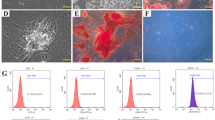Abstract
Objective
To investigate the effects of Heijiangdan Ointment (黑绛丹膏, HJD) on oxidative stress in 60Co γ-ray radiation-induced dermatitis in mice.
Methods
Female Wistar mice with grade 4 radiation dermatitis induced by 60Co γ-rays were randomly divided into four groups (n=12 per group); the HJD-treated, recombinant human epidermal growth factor (rhEGF)-treated, Trolox-treated, and untreated groups, along with a negative control group. On the 11th and 21st days after treatment, 6 mice in each group were chosen for evaluation. The levels of superoxide dismutase (SOD), malondialdehyde (MDA), and lactate dehydrogenase (LDH) were detected using spectrophotometric methods. The fibroblast mitochondria were observed by transmission electron microscopy (TEM). The expressions of fibroblast growth factor 2 (FGF-2) and transforming growth factor β1 (TGF-β1) were analyzed by western blot.
Results
Compared with the untreated group, the levels of SOD, MDA and LDH, on the 11th and 21st days after treatment showed significant difference (P<0.05). TEM analysis indicated that fibroblast mitochondria in the untreated group exhibited swelling and the cristae appeared fractured, while in the HJD group, the swelling of mitochondria was limited and the rough endoplasmic reticulum appeared more relaxed. The expressions of FGF-2 and TGF-β1 increased in the untreated group compared with the negative control group (P<0.05). After treatment, the expression of FGF-2, rhEGF and Trolox in the HJD group were significantly increased compared with the untreated group (P<0.05), or compared with the negative control group (P<0.05). The expression of TGF-β1 showed significant difference between untreated and negative control groups (P<0.05). HJD and Trolox increased the level of TGF-β1 and the difference was marked as compared with the untreated and negative control groups (P<0.05).
Conclusion
HJD relieves oxidative stress-induced injury, increases the antioxidant activity, mitigates the fibroblast mitochondrial damage, up-regulates the expression of growth factor, and promotes mitochondrial repair in mice.
Similar content being viewed by others
References
Salvo N, Barnes E, Van DJ, Stacey E, Mitera G, Breen D, et al. Prophylaxis and management of acute radiation-induced skin reactions: a systematic review of the literature. Curr Oncol 2010;17:94–112.
Mignotte B, Vayssiere JL. Mitochondria and apoptosis. Eur J Biochem 1998;252:1–15.
Yang L, Yu MW, Wang XM. Efficacy evaluation of Heijiangdan treated radiation dermatitis induced by 60Co γ-ray in mice. J Tradit Chin Med (Chin) 2011;52:2040–2042.
Gu QY, Wang DW, Cui YF, Yang H, Zhao ML, Liu J, et al. VEGF expression during the formation and development of radiation-induced skin ulcers and its effects on ulcer healing: a comparative study normal wound healing. Chin J Radiol Health (Chin) 2002;11:196–197.
Zhu B, Wang HM, Zhang ZH. Preliminary discussion on quality control method of Heijiangdan and Xueyu Danhuang Ointment. Chin J Chin Mater Med (Chin) 1995;6:352–354.
Kouvaris J, Kouloulias V, Kokakis J, Matsopoulos G, Myrsini B, Vlahos L.The cytoprotective effect of amifostine in acute radiation dermatitis: a retrospective analysis. Eur J Dermatol 2002;12:458–462.
Manzanas GA, López CMC, Vallejo OC, Samper OP, Delgado PJM, Carretero AE, et al. Superoxidase dismutase (SOD) topical use in oncologic patients: treatment of acute cutaneous toxicity secondary to radiotherapy. Clin Transl Oncol 2008;10:163–167.
Qiao HL, Hou W, Wang B, Tan X. The effect of Chinese Medicine on radiation dermatitis:a review. Beijing J Tradit Chin Med (Chin) 2014;3:231–234.
Yu RC, Ran XQ, Jin L, Hu YF, Wang XM. Clinical and experimental observation on effect of Heijiangdan in the treatment of radiation injury of skin and mucosa. Practical J Cancer (Chin) 1995;10:194–195.
Tang WJ, Wang XM, Yang GW, Zhao WS, Fu Q, Xu YM. Dexamethasone enema in the treatment of chronic radiation proctitis. Chin J Exp Tradit Med Formul (Chin) 2010;16:228–229.
Fu Q, Wang XM, Yang Y, Xu YM, Luo YX, Yang GW. Heijiangdan Ointment in treating radiation dermatitis of 30 cases. J Tradit Chin Med (Chin) 2007;48:1101–1102.
Zhang GL, Li P, Wang XM, Yue XL, Sheng X, Liang DY, et al. Regulative effect of Xueyu Danhuang Ointment on cicatrization and oxidative stress during chronic dermal ulceration induced by epirubicin. J Beijing Univ Tradit Chin Med (Chin) 2008;31:549–552,580.
Ristić B. Radiation recall dermatitis. Int J Dermatol 2004;43:627–631.
Zhao CX, ed. Chinese medicine dermatology. Beijing: Science Press; 1994:24–26.
Pryor WA, Stanley JP. Letter: a suggested mechanism for the production of malondialdehyde during the autoxidation of polyunsaturated fatty acids. Nonenzymatic production of prostaglandin endoperoxides during autoxidation. J Org Chem 1975;40:3615–3617.
Farmer EE, Davoine C. Reactive electrophile species. Curr Opin Plant Bio 2007;10:380–386.
Moore K, Roberts LJ. Measurement of lipid peroxidation. Free Radic Res 1998;28:659–671.
Del Rio D, Stewart AJ, Pellegrini N. A review of recent studies on malondialdehyde as toxic molecule and biological marker of oxidative stress. Nutr Metab Cardiovasc Dis 2005;15:316–328.
Gu QY, Wang DW, Yang ZX, Gao YB, Yang H, Liu J, et al. Expression of b-FGF and b-FGFR3 during the formation and development of acute radiation-induced skin ulcer and their effects on ulcer healing: a comparative study with normal wound healing. Chin J Clin Rehabil (Chin) 2002;4:516–517.
Gu QY, Cao WH, Yang ZX, Yang WF, Sun XL, Gao YB, et al. Expression of several growth factors and their receptors during the foamation and development of acute radiation-induced skin ulcers and effects on ulcer healing: an experimental study. Bulleti Acad Milit Med Sci (Chin) 2001;04:251–254.
Gu QY, Wang DW, Zhao ML, Yang ZX, Gao YB, Yang H, et al. Comparison of EGF and EGFR expression in acute radiation dermatitis and simple wound. J Radiat Res Radiat Proc (Chin) 2003;21:135–138.
Author information
Authors and Affiliations
Corresponding author
Additional information
Supported by the National Natural Science Foundation of China (No. 30973745)
Rights and permissions
About this article
Cite this article
Yang, L., Yu, Mw., Wang, Xm. et al. Heijiangdan Ointment (黑绛丹膏) relieves oxidative stress from radiation dermatitis induced by 60Co γ-ray in mice. Chin. J. Integr. Med. 22, 110–115 (2016). https://doi.org/10.1007/s11655-015-2152-z
Received:
Published:
Issue Date:
DOI: https://doi.org/10.1007/s11655-015-2152-z




